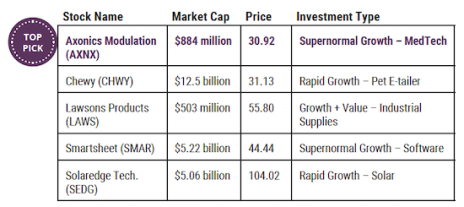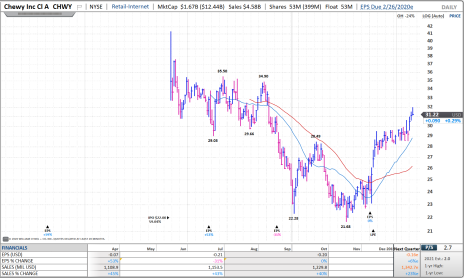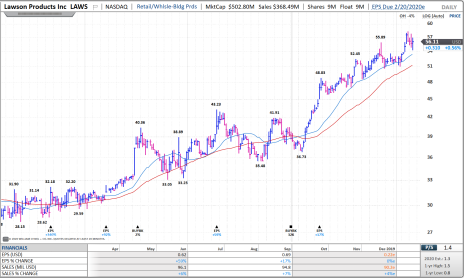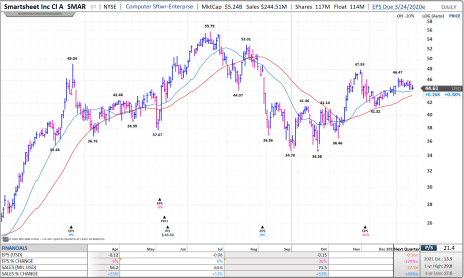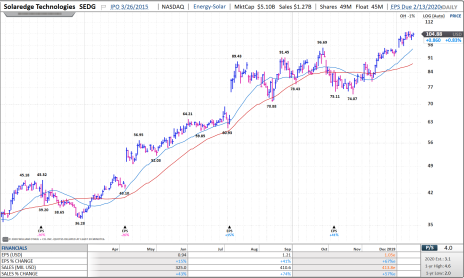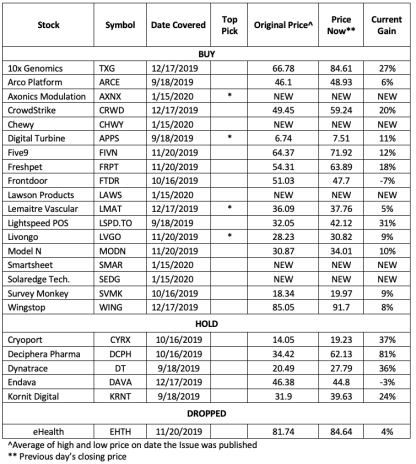The market has been ripping higher with broader participation from sectors that weren’t doing much a couple months ago. That’s the good news. And it’s showing up in the charts with the Small Cap Index at multi-month highs (but well below all-time highs). IPOs are starting to find their legs too. The not-so-good news is that the market is looking a little stretched, which could mean a pause or pullback is coming sooner rather than later. But, the market has a way of doing the unpredictable and with so many investors thinking it’s time for break we could see just the opposite. This month we try to play both sides of the ball by spreading things around in different sectors and across market caps. There’s some IPOs, some high growth software and MedTech ideas, and another growth + value name. They all have their own qualities and stand out to me for different reasons right now.
Cabot Early Opportunities 105
Hero Snow
I grew up skiing in Vermont and got to know different snow conditions well. My favorite is “hero snow”. Hero snow is what you get when you’ve had lots of medium size storms that skiers work into the mountain and which create a superb base. Then you get a big storm that turns the mountain into a massive playground.
Skiing in hero snow is about the most fun thing you can do. It makes everybody better!
The only downside to hero snow is that it’s just so tempting to do things you wouldn’t otherwise do. Sure, taking some risks is part of the fun. But where do you draw the line when the conditions make you feel like one of the Avengers?
I distinctly remember one day many years ago, skiing at a small resort named Castle Mountain in Alberta, Canada. I was there with a good friend, midweek, when it was about -10 degrees Fahrenheit. A series of storms had come through and there were about 18 inches of fresh, light snow that the cold weather kept soft as a feather. There were just the 2 of us and a handful of locals to divvy up the goods.
It was 100% hero snow. On one run we were skiing along at a good clip and I did a big, arcing turn in untracked snow on a part of the trail that resembled something like a massive halfpipe. As it turns out the lip, where I really leaned into my turn, was just some of that good Alberta rock, hidden under a thin layer of powder (something the locals probably knew!).
After a phenomenal wipeout (what skiers call a “yard sale”) in which I shed every piece of equipment without my DNA, I picked myself up, checked to make sure all limbs were still attached (they were), and assessed the damage to my skis. They were destined for the dumpster but would get me through the rest of that day – which I moved through with considerably more caution.
Investing in the current stock market is the equivalent of skiing in hero snow. It seems hard to go wrong!
From the day we launched Cabot Early Opportunities in September 2019, through yesterday’s close, only three of the 20 stocks I’ve featured have failed to go up. Double-digit gains are all over the place! This environment makes us all feel a little too invincible. That’s the danger of hero snow … and investing in a market where just about everything is going higher.
Don’t get me wrong I love it. High fives, fist bumps and backslaps on our investing success are most definitely well deserved. After all, you don’t earn the reward if you don’t take any risk. But at the same time, it’s important to recognize that the market has made investing in early-2020 just a little too easy. Let’s keep in the backs of our minds that at some point a little damage will be inflicted upon us.
It’s up to us each to make sure we stay within the bounds of our abilities and risk tolerances so that when that time comes, we only suffer surface wounds and nothing more.
What to Do Now
The market has been ripping higher and we’d be foolish to think we can predict when it will end. A better strategy is to follow the evidence in front of us and maintain balance by making incremental moves.
Have fun out there but don’t do anything stupid. For stocks you already own this is the time to let your winners run and throttle back on positions that are not looking strong, as we did yesterday with Endava (DAVA), which was moved to hold, and EHealth (EHTH) which was dropped with a modest profit.
Revisit each of your stocks, make sure you remember why you bought each one and think about if you’ll have the conviction to hold through a pullback. When in doubt, don’t do anything – just hold on.
In terms of new buying focus on appropriate position sizing. You don’t need to buy an entire position all at once, and there’s no shame in averaging up with a good stock if it keeps trending higher.
Today’s issue features five stocks across the market cap spectrum and from a wide variety of industries. We have a young but rather large online retailer that’s crushing it in the pet supplies market, a supplier of industrial supplies that you’ve probably never heard of, a solar stock and an innovative software company that’s growing through viral use of its products. Then there’s this month’s Top Pick, a MedTech stock that’s just launched an innovative device that’s grabbing market share from the incumbent.
In short, there’s something for everybody! Enjoy.
STOCKS
Axonics Modulation (AXNX)
Axonics Modulation (AXNX), which has a market cap of $875 million, is an up and coming MedTech stock with a disruptive solution for patients that suffer from overactive bladder (OAB), Urinary Retention (UR) and Fecal Incontinence (FI), the most common symptoms of which are a frequent and urgent need to go to the bathroom. A proven treatment option for these patients is sacral nerve stimulation, a.k.a. sacral neuromodulation (SNM). This involves electrical stimulation therapy via a programmable stimulator implanted in the body to deliver low amplitude electrical stimulation to the sacral nerve, thereby restoring normal control of the bladder and bowel.
Historically, the SNM market has been dominated by Medtronic (MDT). But Axonics leapfrogged the MedTech behemoth by building a better mousetrap, dubbed the Axonics System. Distinguishing features include a miniaturized (60% smaller), long-lived rechargeable neurostimulator, which works for up to 15 years (versus Medtronic’s roughly 5 years), a simple user interface on the remote, and MRI compatibility.
Word on the Street is that physicians are extremely interested in this new offering and that, even with Medtronic set to release its next-gen Interstim Micro in 2020, the stage has been set for Axonics to grab sustainable market share and for total market demand in the SNM space to rise because there’s finally innovation going on (Axonics is working on next-gen products too). The total market in just the U.S. and Europe is over 80 million adults, and Medtronic generates annual SNM sales of almost $700 million from roughly 45,000 patients. Axonics could surpass 12% market share this year and approach 30% within a couple years, all while the SNM market accelerates to 15%+ growth annually.
Revenue growth is massive given that the Axonics System, which runs about $16,000 “installed”, just launched internationally (Europe & Canada) for OAB in November 2018 and in the U.S. late in 2019 (the system is approved for OAB, UR and FI in the U.S., Europe, Canada & Australia). Preliminary Q4 revenue (reported January 9) showed sales outside the U.S. were $1.9 million and within the U.S. were $8.4 million, well ahead of expectations. Management suggested total 2019 revenue should approach $14 million.
Stepping back, Axonics could easily grow revenue to over $80 million in 2020 (up 470%) and then reach $300 million in sales by 2023-2024. We’ll know more as things advance. The company is not profitable and ended 2019 with about $184 million in cash, thanks to a secondary offering in November. That could get it close to breakeven, which could be some point in 2021, depending on how the chips fall.
The Stock
AXNX went public at 15 in October 2018 and got off to a slow start. But shares blasted higher in February 2019 and peaked at 25 before a pullback to 18. The next advance came right away and carried AXNX to 43 by the end of June. A slow decline accelerated into September and shares didn’t find firm ground until they hit 19 in October. The stock has been trending higher since, albeit with some significant jumps after earnings releases, and some pullbacks as well. This stock will likely be volatile so average in.
Chewy Inc. (CHWY)
It’s no secret that pet lovers spend a tidy sum on their furry, feathery and scaly little friends. The sky’s the limit when a member of the family gives unconditional love and is always there! As in most other markets a good deal of the pet supplies business has now moved online. That’s been a boon for Chewy (CHWY), which is now the largest pure-play online retailer for pet supplies in the United States. The company has a market cap of $12 billion.
With a huge selection of over 55,000 products – you can even order live fish online – Chewy has become the standout winner for online pet supplies, partnering with over 1,800 of the best brands in the industry. Private brand offerings have jumped by over 80% in the last year and, along with expansion of the Chewy Pharmacy, have helped drive growth. Customer loyalty and gross profit margins are also trending higher, aided by technology enhancements such as Pet Profiles, digital payment options and the Autoship subscription program, which reached $865 million in sales (over two-thirds of total sales) in Q3 2019, up 50% from the same quarter a year ago.
Chewy has an interesting background. While it just went public in June of 2019, the company was founded in 2011 and acquired by PetSmart in 2017, which was previously acquired by private equity firm BC Partners in 2015. Now, PetSmart and BC Partners are by far the largest holders of Chewy stock, accounting for just over 80% of diluted shares prior to the lockup expiration, which occurred on December 10. Investors should expect the majority shareholders to release shares into the market over time, which will diversify the shareholder base. Note that these are not new shares so they are not dilutive.
In Q3 fiscal 2019 Chewy grew active customers by 33% to 12.7 million, net sales per active customer by 11.4% to $360, and total revenue by 40% to $1.23 billion. That puts the company on pace to deliver revenue of just over $4.8 billion (up 37%) in 2019. Chewy is not yet profitable (estimated 2019 EPS loss is -$0.31) but should be just above breakeven in 2020. With online pet sales still representing only 20% or so of the market, a leadership position, and still reasonable valuation, there’s likely more room for this stock to run.
The Stock
CHWY went public at 22 on June 14, 2019 and shot up 59% in its first day. It peaked near 41, then settled down to trade in the 30 to 35 range through early-September. Shares then retreated into the low 20s, bounced back to 28.5, and fell back near 22 in mid-November. They firmed up heading into Q3 earnings (December 9) and lockup expiration (December 10) then rallied back above 28 by the end of the month. The stock has been advancing steadily since and trades just above 30 now.
Lawson Products (LAWS)
Lawson Products (LAWS) is our boring stock of the month. How else do you characterize a company that distributes maintenance and repair supplies like bolts, cutting tools, chemicals and proactive clothing to small and midsize businesses? The average price of the pieces Lawson sells is just 94 cents for crying out loud! But there’s more to this story.
Lawson, which has a market cap just under $500 million, dates back to the 1950s when it was started in Chicago by Sidney Port, who was trying to make a living by selling fasteners out of his car trunk. It went public in 1970 and did fine through the mid-2000s when the stock peaked at 54. But the wheels started to come off during the Great Recession and without any real competitive moat Lawson was overdue for a shakeup.
That came in the form of a new CEO, Michael DeCata, who took the helm (when the stock was worth just 6) in 2012 after stints at Chef’s Warehouse (CHEF), United Rentals (URI) and Grainger (GWW). Mr. DeCata is a fan of focusing on the small things and continually improving them until he sits atop a well-oiled machine. That’s a good match for this company, which sells products that help their customers achieve the same goal. It’s this relentless focus on process improvements that has restored growth and driven the stock to a recent all-time high.
Lawson sells products all over North America for just about every industrial market out there, including automotive supplies, fasteners, shop supplies, storage solutions, hand tools, welding supplies, material handling equipment and more. As DeCata put it, these things might not seem important until a $400,000 excavator goes down because of a broken part that only costs $1.00.
To stay ahead of the game Lawson focuses on customer service and building a comprehensive line of consumables for the Maintenance, Repair and Overhaul (MRO) market, including private label products. Its high touch value proposition, which now includes vendor managed inventory (VMI) solutions—where Lawson manages the inventory at customer locations so they always have what they need—has helped Lawson retain over 90% of customer revenue every year.
Aided by new sales reps, better production as reps age with Lawson, and strategic acquisitions, DeCata’s well-oiled machine grew revenue by 14% in 2018, when it also doubled EPS (to $1.42). Sales growth will dip to around 6% this year but investors should expect more acquisitions in the future to boost growth.
The Stock
LAWS has been around forever, but we’re really interested in the time after the new CEO DeCata came on board in 2012. At that point the stock was trading at multi-decade lows near 6. It’s been trending higher, with some normal looking pullbacks, ever since. There was a long consolidation from September 2018 through April 2019 when LAWS traded between 28 and 37, and another in late summer when LAWS was stuck between 35.5 and 43. Shares broke out in October after Q3 earnings came out and have advanced steadily to the mid-50s since.
Smartsheet (SMAR)
Smartsheet (SMAR) is a $5.3 billion market cap software company that was founded in 2005, went public in 2018 and is growing at a better-than 50% quarterly clip today. What’s the scoop behind the success? The company has developed a flexible, cloud-based, low-code collaboration platform that helps teams organize, capture, manage, automate and report on their work at a huge scale. The result is the Holy Grail of corporate leader aspirations; more efficient processes and better business outcomes.
The market for Smartsheet’s products is mostly business users that just want to get more done, more quickly and with less hassle. This often means a better solution than what was previously handled through email, spreadsheets and whiteboards. That, combined with a user interface that’s familiar (similar to MS Excel and Google Sheets), is why the company’s products have been spreading virally, reaching almost 100,000 customers of all sizes, including over 75% of the Fortune 500. It’s even penetrated the brick walls of Cabot’s head office in Salem, MA. Need I say more!?
But seriously, Smartsheet’s solutions are more than just glorified Microsoft Excel spreadsheets that require another subscription. The platform integrates with a huge variety of other enterprise tools, including those from Microsoft, Slack, Google, Tableau, Facebook, Okta and more. There are over 2,000 use cases covering all the unstructured projects that business users need help streamlining.
The company achieved FedRAMP authorization back in August, which drove federal agencies like the National Oceanic and Atmospheric Administration (NOAA) to become the first customers on shartsheet.gov. All in, analysts see the company targeting a $21 billion market. And Smartsheet has only grabbed about 1% of it.
To keep growth alive and well Smartsheet is expanding overseas, developing more Accelerators (automated smartsheets for specific projects) and building out more integrations, including one with Adobe Creative Cloud. These high value offerings are helping to drive 130% plus net revenue retention (showing existing customers spending more) and revenue growth north of 50%.
In the most recent quarter (Q3 Fiscal 2020) revenue jumped 53% to $71.5 million. Analysts see another 50% jump in Q4. While the company is not profitable (adjusted EPS in Q3 was -$0.15) due to investments (which will likely continue for years), investors will likely be fine with that (for now) given the supernatural growth profile.
The Stock
SMAR came public at 15 on April 27, 2018 and shot up 30% on the first day of trading. The stock seesawed between 34 and 20 for a few months then broke out above previous highs in late-February and rallied to 49. After a little dip to 36, SMAR advanced to its all-time high of 55.8 on July 19. Shares then retreated (along with most other software stocks) and have chopped around for a few months. Now trading near 45, SMAR is one of the few high growth software stocks that hasn’t taken off in early 2020.
SolarEdge Technologies (SEDG)
SolarEdge (SEDG) is one of the companies benefiting from growing adoption of solar systems. The company, which went public in 2015 and has a market cap of $4.9 billion, has invented a smart string inverter solution that’s a game-changer in harvesting power and managing it in a solar photovoltaic (PV) system for residential and commercial use. The company also makes power optimizers, which are electronics that attach to the back of solar panels.
In a SolarEdge DC system each PV module is connected to the intelligent power optimizer electronic chip that maximizes energy from that module individually. This means if one module is messed up, dirty or covered with snow, the others run unaffected. Think of it like a system that lets any given bulb in a Christmas light strand break, without affecting how any of the other lights perform. The company’s string inverter system is more expensive than more simple string-array systems, but more cost effective than micro inverter systems, which require an inverter for every PV module.
The company is in the sweet spot because every solar array needs an inverter to convert the direct current (DC) into alternating current (AC), which is required to power household appliances, heating, cooling and lighting systems, and to permit the transmission, distribution and storage of the power. As the volume of installed solar panels goes up, so too does the volume of inverters.
Big picture, that means SolarEdge should grow as the rooftop and distributed solar market grows. Industry analysts see rooftop and distributed solar as the fastest growing area of the market due to declining technology costs, increasing efficiency, wider use cases (i.e. electric vehicle charging) and ease of use for first-time buyers, remote locations and emerging economies. Just to point to two examples, California recently mandated that all new residential homes include rooftop solar systems as of the beginning of 2020. And Texas is ramping up solar use because it is now the lowest cost source of electricity in the state.
Revenue was up 74% to $411 million in Q3 and is seen rising 52%, to $1.42 billion, 2019. The company is also profitable. It grew Q3 EPS by 41% to $1.21 and is expected to see EPS hit $2.91 this year (an 8% decline due to a slow first quarter) and $4.90 in 2020.
The Stock
SEDG went public in March 2015 and advanced soon after, peaking just above 40 before it succumbed to a harsh correction in 2016 that saw shares trade below 15. SEDG roared back in 2017 as growth picked up and the stock traded up near 70 before another correction cut it in half by the end of 2018. It then rallied again, finally breaking out to new all-time highs above 70 last summer. SEDG hit 96.7 before a 23% correction, then broke out to fresh highs in early-2020.
Previously Recommended Stocks
Below you’ll find previously recommended Cabot Early Opportunities stocks. Stocks rated BUY are suitable for purchasing now. In all cases, and especially recent IPOs, I suggest averaging into every stock to spread out your cost basis.
Those rated HOLD are stocks that still look good and are recommended to be kept in a long-term oriented portfolio. Or they’ve pulled back a little and are under consideration for being dropped.
Stocks rated DROPPED didn’t pan out, or the uptrend has run its course for the time being. They should be sold if you own them. DROPPED stocks are listed in one monthly Issue, then they fall off the DROPPED list and into oblivion.
Please use this list to keep up with my latest thinking, and don’t hesitate to call or email with any questions.
Our top performer continues to be HOLD rated Deciphera Pharmaceuticals (DCPH), which was featured in October and even after a dip in late-2019 is still up over 80%. Up and commers include HOLD rated Cryoport (CYRX), up 37%, Lightspeed (LSPD.TO), up 31%, and 10X Genomics (TGX), up 27%.
Detractors from performance are BUY rated Frontdoor (FTDR) featured in October and down -7%, and HOLD rated Endava (DAVA), featured in December and down -3%.
Two stocks are being moved to HOLD today, including Dynatrace (DT), up 36% and Kornit Digital (KRNT), up 24%.
No stocks are being DROPPED today.
In terms of what looks particularly good right now check out BUY rated Survey Monkey (SVMK), which has just broken out to all-time highs. It’s also hard to ignore the strength in 10x Genomics (TXG) and CrowdStrike (CRWD).
The next Cabot Early Opportunities issue will be published on February 19, 2020.
Cabot Wealth Network
Publishing independent investment advice since 1970.
CEO & Chief Investment Strategist: Timothy Lutts
President & Publisher: Ed Coburn
176 North Street, PO Box 2049, Salem, MA 01970 USA
800-326-8826 | support@cabotwealth.com | CabotWealth.com
Copyright © 2020. All rights reserved. Copying or electronic transmission of this information is a violation of copyright law. For the protection of our subscribers, copyright violations will result in immediate termination of all subscriptions without refund. No Conflicts: Cabot Wealth Network exists to serve you, our readers. We derive 100% of our revenue, or close to it, from selling subscriptions to its publications. Neither Cabot Wealth Network nor our employees are compensated in any way by the companies whose stocks we recommend or providers of associated financial services. Disclaimer: Sources of information are believed to be reliable but they are not guaranteed to be complete or error-free. Recommendations, opinions or suggestions are given with the understanding that subscribers acting on information assume all risks involved. Buy/Sell Recommendations: All recommendations are made in regular issues or email alerts or updates and posted on the private subscriber web page.

